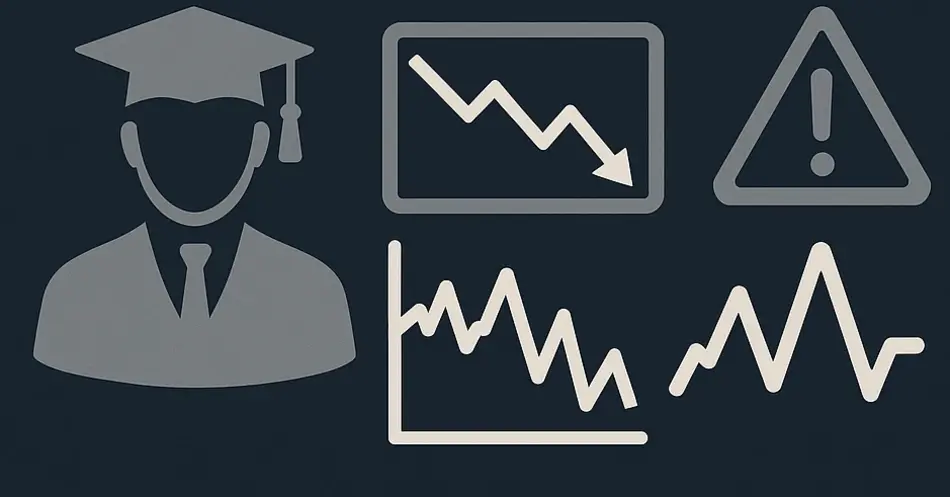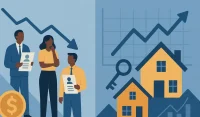The Perfect Storm of Economic Uncertainty
The United States is facing unprecedented shocking economic uncertainty 2025 that threatens to reshape the financial landscape and potentially trigger a recession, according to Harvard professor Carmen Reinhart. In a comprehensive analysis of current economic conditions, Professor Reinhart identifies multiple converging factors that are creating what she describes as “uncertainty off the charts” – a situation that could have profound implications for investors, businesses, and everyday Americans.
The convergence of policy uncertainty from tariffs, unresolved fiscal issues, and President Trump’s attacks on the Federal Reserve, combined with geopolitical tensions, has created a perfect storm of economic instability that markets and the economy have so far digested comparatively well, but at a scale far beyond normal parameters.
Policy Uncertainty: The Primary Threat to Economic Growth
Professor Reinhart identifies uncertainty as the biggest threat to U.S. economic growth, covering multiple dimensions that are unprecedented in their scope and intensity. The policy uncertainty stems from various sources, including ongoing tariff disputes, unresolved fiscal issues, and the administration’s confrontational stance toward the Federal Reserve.
This multifaceted uncertainty creates a challenging environment for both investors and corporate managers, as the lack of clear policy direction makes long-term planning increasingly difficult. The professor emphasizes that uncertainty is particularly damaging to investment decisions, as evidenced by the literature showing that uncertainty is the enemy of investment.
The current environment has led to a noticeable shift in corporate behavior, with many companies delaying medium and longer-term investment plans due to the unpredictable policy landscape. This hesitancy could have significant implications for economic growth and job creation in the coming months and years.
Market Volatility: A New Normal for Investors
The era of low volatility that characterized the period between the global financial crisis and the Federal Reserve’s recent tightening cycle appears to be over, according to Professor Reinhart’s analysis. Investors who became accustomed to exceptionally low interest rates and stable market conditions must now prepare for a fundamentally different environment.
While the VIX in equity markets may not appear exceptional, the professor points to significant volatility in fixed income markets and currency markets that suggests a broader trend toward increased market instability. This shift requires investors to adopt new strategies and risk management approaches that account for higher volatility on a longer-term basis.
The transition from a low-volatility environment to one characterized by uncertainty and instability represents a fundamental change in market dynamics that could affect everything from retirement planning to corporate financing decisions.
Looking to Hire Fast?
Hiring managers can now post jobs for free on WhatJobs and connect with millions of jobseekers.
Recession Risks: Higher Than Average but Not Overwhelming
The question of whether the United States is heading toward a recession remains the “question of the day,” according to Professor Reinhart, who acknowledges the difficulty of making such predictions. Her analysis reveals that while recession risks are higher than average, they don’t reach the overwhelming odds that were present around what she refers to as “Liberation Day.”
The U.S. economy has shown remarkable resilience despite the tightening cycle initiated by the Federal Reserve. The consumer sector remains in relatively good shape, with spending patterns that have helped sustain economic activity even in the face of uncertainty about tariff impacts.
However, the professor identifies several concerning factors that could contribute to recession risks, including the impact of immigration policy changes on employment growth and the potential for slower population growth to affect medium-term potential output. These demographic factors, combined with policy uncertainty, create a complex economic landscape that requires careful monitoring.
The Federal Reserve’s Role in Economic Stability
As a former Federal Reserve employee, Professor Reinhart brings unique insights to the question of the central bank’s role in preventing recession. Her analysis suggests that the current economic conditions don’t necessarily warrant lower interest rates, despite calls for more aggressive monetary policy easing.
The uncertainty about future inflation represents a significant factor in monetary policy decisions, according to the professor. While the pass-through of tariffs into higher prices has been modest so far, the early stages of this process suggest that inflation concerns should remain high on the list of policy considerations.
Professor Reinhart aligns with Chairman Powell’s emphasis on data dependence in monetary policy, noting that the signs of overwhelming economic weakness that would justify monetary policy stimulus are not currently present. Various indicators suggest that the current monetary policy stance is not particularly tight, with real interest rates remaining within reasonable historical norms.
Immigration’s Impact on Economic Growth
The professor’s personal experience as a Cuban immigrant to the United States provides valuable perspective on the economic implications of immigration policy. She emphasizes that immigration has historically been a contributor to trend growth, particularly important given the demographic challenges facing advanced economies.
The aging population and declining birth rates that characterize the United States and other advanced economies create significant challenges for potential economic growth. Immigration has traditionally helped offset these demographic headwinds, making the current trend toward less welcoming immigration policies concerning from an economic perspective.
The connection between immigration policy and economic growth represents a critical factor in long-term economic planning, as changes in immigration patterns could have lasting effects on labor force growth and overall economic potential.
The Growing Debt Crisis and Its Implications
President Trump’s recent budget bill, which is estimated to add at least $3 trillion to the deficit over the next decade, raises significant concerns about fiscal sustainability. Professor Reinhart emphasizes that the “kick the can down the road” approach to debt management creates problems that future generations will have to address.
The professor challenges the previously held view that high debt levels were manageable due to expectations of permanently low interest rates. The current environment suggests that this assumption may no longer be valid, creating concerns about higher debt servicing costs and their impact on economic growth.
The diversion of resources toward debt servicing rather than more productive, growth-enhancing investments represents a significant economic concern that could affect everything from infrastructure development to social programs.
The Decline of Globalization and Its Economic Impact
The trend toward de-globalization, accelerated by President Trump’s policies aimed at bringing manufacturing back to the United States, represents another significant factor in the shocking economic uncertainty 2025. Professor Reinhart notes that this trend has been developing since the global financial crisis, with Brexit and the first round of Trump’s China policies contributing to the decline.
While globalization has benefited U.S. consumers through greater product variety and lower prices, it has also contributed to the hollowing out of various manufacturing sectors. The professor expresses skepticism about the ability to bring back significant portions of the manufacturing that has left the United States, suggesting that the economic benefits of globalization may not be easily reversed.
The economic implications of de-globalization extend beyond trade, as reduced global cooperation could have negative geopolitical consequences that shouldn’t be underestimated in economic analysis.
Emerging Market Debt Crisis: A Hidden Risk
Professor Reinhart identifies the unfolding debt crisis in many low-income countries as a significant risk factor that receives insufficient attention. While these crises may not currently pose systemic risks to international capital markets, the professor warns against complacency.
The historical precedent of Mexico’s 1982 default, which significantly influenced Paul Volcker’s monetary policy decisions, serves as a reminder that emerging market crises can have far-reaching consequences. If debt problems were to spread to emerging markets with larger economic footprints, the impact could extend well beyond their borders.
This hidden risk factor adds another layer of complexity to the already challenging economic environment, requiring investors and policymakers to consider a broader range of potential disruptions.
Investment Strategies for Uncertain Times
Given the unprecedented level of shocking economic uncertainty 2025, Professor Reinhart emphasizes the importance of hedging strategies for investors. The transition from a low-volatility environment to one characterized by uncertainty requires a fundamental reassessment of investment approaches.
Corporate managers must also adapt to this new environment, recognizing that uncertainty is particularly damaging to investment decisions. The literature on investment drivers consistently shows that uncertainty is the enemy of capital expenditure, making it essential for businesses to develop strategies that account for this reality.
The need for both individual and corporate adaptation to higher volatility and uncertainty represents a significant challenge that will likely persist for the foreseeable future.
The Consumer’s Role in Economic Resilience
Despite the various challenges facing the economy, the consumer sector has shown remarkable resilience, according to Professor Reinhart’s analysis. Consumer spending has helped sustain economic activity even as uncertainty about tariff impacts and other policy changes has increased.
This consumer resilience has been particularly important in preventing the economic slowdown from developing into a more severe downturn. However, the sustainability of this consumer strength remains uncertain, particularly given the potential for policy changes to affect household finances and confidence.
The consumer’s continued ability to support economic growth represents a critical factor in determining whether the current economic challenges will develop into a more severe recession.
Long-term Economic Implications
The combination of policy uncertainty, demographic challenges, debt concerns, and de-globalization trends creates a complex economic landscape that will likely have lasting implications. Professor Reinhart’s analysis suggests that the current period of shocking economic uncertainty 2025 may represent a fundamental shift in economic conditions rather than a temporary disruption.
The long-term implications of these changes could affect everything from retirement planning and investment strategies to corporate decision-making and government policy. Understanding these implications is essential for anyone making long-term financial or business decisions.
The professor’s emphasis on the need to recognize that the era of low volatility and low interest rates has ended represents a crucial insight for economic planning and decision-making.
Conclusion: Navigating an Uncertain Economic Future
The shocking economic uncertainty 2025 identified by Professor Reinhart represents a fundamental challenge for investors, businesses, and policymakers. The convergence of multiple risk factors creates an environment that requires careful navigation and strategic planning.
While the current economic resilience provides some cause for optimism, the underlying uncertainties and risk factors suggest that continued vigilance and adaptation will be necessary. The transition from a low-volatility environment to one characterized by uncertainty and potential instability represents a significant challenge that will likely persist for the foreseeable future.
The key to successfully navigating this environment lies in recognizing the fundamental changes that have occurred and adapting strategies accordingly. Whether through hedging strategies for investors, flexible planning for businesses, or careful policy management for governments, the ability to adapt to this new economic reality will be crucial for long-term success.
FAQ Section
What are the main causes of shocking economic uncertainty 2025?
The shocking economic uncertainty 2025 is primarily driven by policy uncertainty from tariffs, unresolved fiscal issues, President Trump’s attacks on the Federal Reserve, and geopolitical tensions. Harvard professor Carmen Reinhart describes this uncertainty as “off the charts” compared to normal economic conditions.
How does shocking economic uncertainty 2025 affect investment decisions?
The shocking economic uncertainty 2025 is particularly damaging to investment decisions, as uncertainty is the enemy of capital expenditure according to economic literature. Corporate managers are delaying medium and longer-term investment plans due to the unpredictable policy landscape, which could have significant implications for economic growth and job creation.
What are the recession risks associated with shocking economic uncertainty 2025?
According to Professor Reinhart’s analysis, recession risks are higher than average due to the shocking economic uncertainty 2025, but not overwhelming. The U.S. economy has shown resilience, with consumer spending helping sustain economic activity despite policy uncertainty and tariff concerns.
How should investors protect their portfolios during shocking economic uncertainty 2025?
During shocking economic uncertainty 2025, Professor Reinhart recommends hedging strategies and preparation for higher volatility on a longer-term basis. The era of low volatility and low interest rates has ended, requiring investors to adopt new strategies that account for increased market instability.




